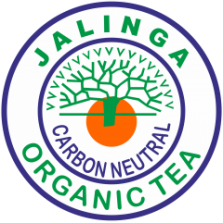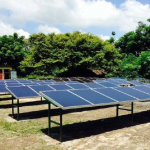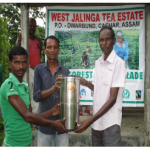Composting
Scholars Research Library
Central European Journal of Experimental Biology, 2014, 3 (4):41-51
(http://scholarsresearchlibrary.com/archive.html)
ISSN: 2278–7364

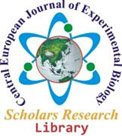
Evaluation of On- farm produced Novcom Compost Quality and its Post Soil Application Effectivity in Acid Tea Soils – A Case Study from West Jalinga Tea Estate, the Largest Organic Tea Estate in Assam, India.
- Bera, A. Seal, A. Datta, S. Saha, A.K. Dolui, A.K. Chatterjee, A.K. Barik, G.C. De and D. Majumdar
Inhana Organic Research Foundation (IORF), West Bengal, India
Dept. of Soil Science, Institute of Agricultural Science, Calcutta University, India
Dept. of Soil Science, Visva Bharati University, West Bengal, India
Dept. of Agronomy, Visva Bharati University, West Bengal, India
Dept. of Statistics, Bidhan Chandra Krishi University, West Bengal, India
ABSTRACT
A new composting process known as Novcom composting method is being used for on-farm production of compost at West Jalinga Tea Estate (presently largest certified organic tea estate in Assam, India). The method has been developed by Dr. P. Das Biswas, an Indian Scientist who has been associated with organic research for the last decade. Novcom compost produced under this method is being used for soil management in the garden. The composting process enables production of mature compost within a period of 21 days. Quality of Novcom compost and its post soil application effectivity in terms of soil development were studied during the period 2006-7 to 2012-
- The samples were analyzed for physicochemical properties, nutrient content, ready nutrient supplying potential, microbial status, stability, maturity and phytotoxicity status; and the values obtained for the different parameters were within the standard suggested reference range. Soil microbial population increased by 1,000 to 10,000 times, apart from significant increase recorded in case of soil organic carbon (49.4%) and soil fertility (Available-N: 13.6%, P2O5: 5.8% and K2O: 9.5%). Post soil application effectivity of Novcom compost was documented both in terms of significant soil quality development as well as yield sustenance at West Jalinga T.E. which had been applying the compost @ 3 ton/ha/year; over a period of seven years. The study revealed that Novcom composting method could serve as an alternate option for production of good quality on-farm compost in order to enable effective soil management.
Keywords: Biodegradation, Maturity, Phytotoxicity, Self- generated microbes, Soil development
INTRODUCTION
Compost is considered to be the most effective and therefore widely recommended for soil quality rejuvenation. Moreover, with the increasing necessity for organic agriculture to ensure soil and crop sustainability, importance of compost increases many folds. There is a common belief that addition of compost can never harm the soil, plant or water ecosystem but such an assumption is not correct. Immature compost when applied to the soil continues to decompose and produce odorous gases and products such as ammonia in its immediate surroundings that are often toxic to plants. Immature compost can induce high microbial activity and subsequent misappropriation of oxygen. In the presence of such inhibitory environment, plants typically reduce their metabolic rate and build up their resistance. Immature compost with a high carbon/ nitrogen ratio (C:N) cause nitrogen immobilization, starve roots of oxygen due to high microbial activity, support growth of pathogens as well as create high levels of organic acids. Simultaneously a low C/ N ratio in compost can create high ammonia concentrations in soil resulting in ammonium toxicity in plants. Numerous organic amendments have also exhibited direct or indirect inhibitory effect on seed germination.
In the tea growing zone of Cachar (Assam, India) where soil erosion, low organic carbon content and the inherently low soil microbial population (due to acidic environment) are the major problems; relevance of compost towards soil quality development can be well understood. However, the quantitative requirement of compost for meeting the crop nutritional requirement and to ensure effective soil management is, becoming a critical issue for the organic tea gardens. Such huge quantity of compost is difficult to produce on-farm using the limited resources of tea gardens and their off-farm procurement in turn causes economic burden on the garden owners. However, soil, crop and economic sustainability can be ensured even under minimal quantity application only if the focus is shifted towards compost quality. Hence, evaluation of input/ compost quality and its effectively post soil application should be the regulating criteria in order to ensure soil and crop sustenance under organic cultivation. The present study was aimed to evaluate the quality of compost produced under Novcom composting method along with assessment of its effectively post soil application in acid tea soils.
MATERIALS AND METHODS
Experimental site: Available green matter comprising of various garden weeds were composted aerobically by Novcom composting method at W. Jalinga Tea Estate i.e. a certified organic tea garden in Cachar (Assam, India). Compost samples were drawn from 36 batches of compost produced during 2006-2007 to 2012-2013. 60 surface soil samples were collected from different sections of the plantation before application of Novcom compost in the month of December and then again in 2013 i.e. post seven years of Novcom compost application at the rate of 3 ton/ ha/ year. Soil and compost samples were air dried and sieved. Soil samples were analyzed for physicochemical properties, fertility and microbial status while compost samples were tested for physicochemical properties, nutrient content, microbial properties, stability, maturity and phytotoxicity status.

Novcom solution: Novcom solution is a research product developed by eminent Indian scientist Dr. P. Das Biswas (Founder Director of Inhana Biosciences which is a R&D organization based in Kolkata, India & pioneer in scientific organic farming in India) and is based on the Element Energy Activation (E.E.A.) Principle. Radiant solar energy is stored in plants and the bound stored energy components are extracted from energy-rich plant parts using a specific extraction procedure and subsequently potentized in the order of 103 to 104. The process flowchart of Novcom Solution under E.E.A. principle is provided in Seal et al. 2012 [7]. The solution contains biologically activated and potentized extracts of Cynodon dactylon, Sida cordifolia L. and Ocimum bascilicum. This solution is used for spraying on raw material during erection of the Novcom compost heap and further on 7 and 14th day of composting, i.e. during restructuring of heap.
How Novcom Composting Method works :
Novcom Composting Method Advocates Six Steps of Bio-degradation
- High Temperature of 65-700 C to pasteurize and kill
- Production of Thermophilic Bacteria & Actinomycetes
- Preventing the proliferation of mineralizing bacteria and loss of valuable substances and preparation of the field for fungi.
- Temperature falls. Manure worms & crustaceans chew up org.
- Break up of organic matter and multiplication of fungi.
- Break up of cellulose and lignin fiber into simpler
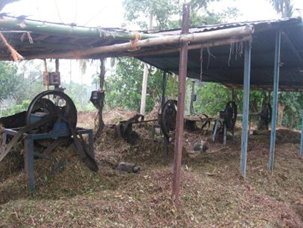
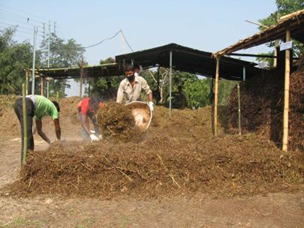
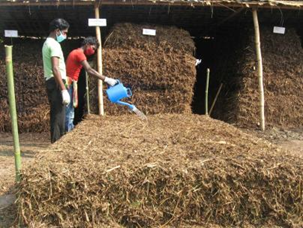
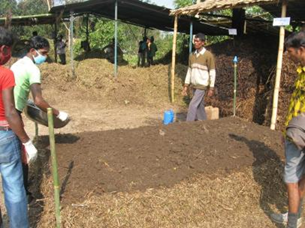
In the Novcom composting process the high temperature of 65-700C pasteurizes and kills pathogens. At the same time thermophilic bacteria and actinomycetes are produced while proliferation of mineralizing bacteria is prevented and thereby loss of valuable substances is restricted. The first stage of decomposition henceforth prepares the field for fungi. After a period of 12-14 days from initiation, the temperature falls. At this stage manure worms chew organic matter and enables its breakdown as well as multiplication of fungi takes place. This if followed by the last and the final segment where cellulose and lignin components are acted upon by the fungal population. Lignin, a complex polymer of phenyl-propane units can only be broken-down by the necessary enzymes produced by certain fungi and the most scientific process is to attain such degradation only at the last stage of the decomposition process. This stage if tried to prepone unnecessarily by adding any microbial culture or any agent hinders the bio- availability of other constituents by reducing the surface area available for enzymatic penetration and activity. The degradation process continues further for a period of 7-8 days after which the final matured compost is ready for use within 21 days of initiation.
Production details of Novcom compost:
Day 1 : At a selected upland and flat area chopped green matter was spread to make a base layer measuring 10 ft. in length, 8 ft. in breadth and 1 ft. in thickness. This layer was sprinkled thoroughly with diluted Novcom solution (5 ml/ ltr. of water) and over this layer, a layer of cow dung (3 inches in thickness) was made followed by a second layer of chopped green material, once again 1 ft. in thickness. The green matter layer was once again sprinkled with diluted Novcom solution (5 ml/ ltr. of water) and the process was continued till the total height of the heap reached to about 6 ft. After construction of each layer of green matter it was compressed downward from the top and inward from the sides to make compact heap.
Day 7 : On the 7th day compost heap was demolished and churned properly. Next the material was laid layer wise (of 1 ft. thickness) and after making each layer diluted Novcom solution (5 ml/ ltr.) was sprinkled thoroughly as done on 1st day. After seven days the volume of composting material decreased due to progress in decomposition process. Hence, to maintain the heap height to about 6 ft.; the length and breadth of the heap was reduced to 8 ft. X 6 ft. respectively. The heap was once again made compact as described earlier.
Day 15 : The same process as on day 7 was repeated and to maintain heap height to about 6 ft., the length and breadth of the heap was further modified to 7 ft. X 5 ft. respectively.
Day 22 : The composting process was complete and Novcom compost was ready for use.
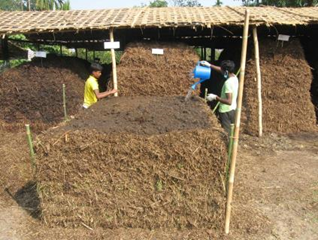
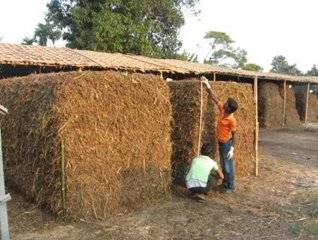
Research methodology:
Physicochemical properties of compost viz. moisture content, bulk density, porosity, water holding capacity, buffering capacity, pH, EC, organic carbon and total volatile solids was analyzed according to the standard procedure. Cation exchange capacity was measured following the method of. Total N, P and K in compost was determined by acid digestion method. Determination of ammonium, nitrate, water soluble carbon, inorganic nitrogen and organic nitrogen was done according to the method of. Estimation of bacteria, fungi and actinomycetes was done using Thornton’s media, Martin’s media and Jensen’s media following the procedure outlined by. Microbial biomass carbon was done using dichromate oxidation method of. Stability test of compost (viz. CO2 evolution rate and phytotoxicity bioassay test) were performed according to the standard procedure. Cress (Lepidiun sativum L.) seeds were used for phytotoxicity bioassay test.
Soil physicochemical and fertility parameters were analyzed as per standard procedure suggested by while soil microbial study was done as per the methodology of. Statistical Analysis in terms of Standard Error and Paired Samples Test were performed with SPSS software (version 7.2).
RESULTS AND DISCUSSION
The quality evaluation study of Novcom compost comprising 33 different analytical parameters was taken up to assess the quality and maturity of compost produced under Novcom composting method. Under this study Novcom compost samples were analyzed for physicochemical properties, nutrient content, microbial status, stability and maturity/ phytotoxicity
Physical properties of compost
Novcom compost appeared dark brown in colour with a characteristic earthy smell, which are often deemed necessary for mature compost [15]. Average moisture varied from 45.23 to 64.30 percent, which may be placed under high value range (40 to 50) as per the rating of [16]. Bulk density of the samples (0.52 to 0.78 g/cc), were in accordance with the standard range (0.4 to 0.7 g/cc) as suggested by the U.S Composting Council (2002) [17] while porosity ranged from 48.0 to 69.0 percent (Table 1). Water holding capacity of 112 to 148 percent, represented the high value range (standard range of 100 to 200 with preferred value of >100) as per the rating of [16]. Water holding capacity may be attributed to the abundance of humus particles in compost [8] and the addition of such compost in soil helped in retaining soil moisture during dry months
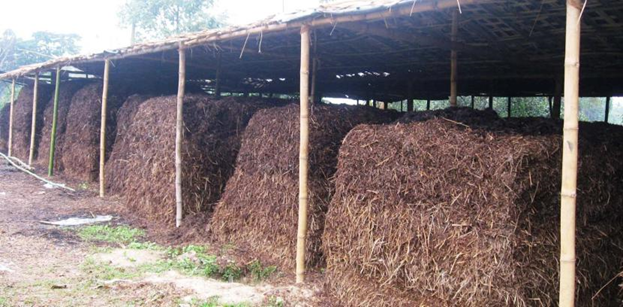

Physicochemical properties of compost
The pH value of compost is important, since applying compost to the soil can alter the soil pH which in turn can affect the availability of nutrients to the plant. Ideally pH of compost should be alkaline, which substantiates an effective fermentation process. As the wider C:N ratio becomes narrower with progress in decomposition, the pH also changes from acidic to alkaline due to decrease in acidic by products towards completion of composting. pH value of compost samples ranged between 7.20 and 8.71 with mean of 7.80, which was well within the stipulated range as indicated for good compost quality as well as maturity. Electrical conductivity value ranged between 1.08 and 2.87 with mean 2.05, indicating its high nutrient status. The organic carbon content of compost is a necessary parameter for determining compost application rate for sustainable agricultural production. Total ash content and volatile solids in Novcom compost, which indicated the degree of compost biodegradation; varied between 47.0 and 53.0 percent, remaining well within the standard suggested range as suggested for mature compost. Organic carbon content in compost samples ranged between 23.9 to 34.4 percent with mean value of 29.4, qualifying (with few exceptions) even the standard value of >19.4 percent as suggested for nursery application. CEC is one of the most important properties of compost and is usually closely related to fertility. The cation exchange capacity of the compost samples ranged between 123 to 285 cmol (p+)kg-1, which is comparable to the values obtained for any good quality compost as per. The high buffering capacity of compost (range value 48 to 82 meqH+L-1) once again suggested the abundance of organic colloids, which in turn substantiated the high CEC value. Compost mineralization index (CMI) expressed as ash content/ oxidizable carbon indicated the ready nutrient supplying potential of compost and the value obtained (range 1.10 to 2.39) again complied with the standard suggested range for mature compost. Sorption capacity index expressed as the ratio of cation exchange capacity/ organic carbon, reflected the degree of maturity of specific humic compounds and the value obtained for Novcom compost was in conformity to the suggested value of >1.7 for well humified manures .
Nutrient status of compost:
Although thirty six different nutrients are required for plant growth, but the macronutrients (N, P and K) contribution of compost is usually of major interest. The total nitrogen content in the compost samples ranged between 1.48 and 3.23 percent, which was well above the reference range as suggested by. Considering the average nitrogen content in raw material (total- N 1.3 percent for green matter and 0.98 percent for cow dung), appreciation in its value (> 90 percent considering mean N value in raw materials and final compost) in final Novcom compost clearly confirmed the fixation of atmospheric nitrogen by naturally generated autotrophic organisms, during the composting process. Similar observation was also made by other workers during their study of compost quality produced under Novcom composting method. Mean value of total phosphate and total potash (0.87 and 0.93 percent respectively) were also higher than the minimum suggested standard by. Hence, compared with the standard suggested range for N, P, K , the value obtained for Novcom compost were in the upper range, which clearly authenticated its rich nutrient status. This could be corroborated by the sustained crop production (Fig. 1) in W. Jalinga Tea Estate even under application of Novcom compost at a low rate of 3 ton ha-1.
The ideal C/N ratio of any mature compost should be about 10.0, as in humus; but it can be hardly achieved in composting. However, of greater importance is its critical value (C/N ratio 20), below which further decomposition of compost in soil does not entail soil nitrogen mining but in turn released mineral nitrogen into soil. C/N ratio obtained for Novcom compost (range 10:1 to 18:1) were well within the suggested values, thereby indicating its good nutrient mineralization potential.
Microbial status of compost:
Most organic substrates draw an indigenous population of microbes from the environment. In case of open-air composting processes, further colonization in compost material occurs naturally during construction and turning of heaps. In this respect Novcom compost exhibited very high self- generated microbial status (in order of 1016 )
c.f.u per gram moist compost), which can be corroborated to the uniqueness of Novcom composting method in term of fastest conversion (within 21 days) as well as the high nutrient content of compost. This can be contributed only by the high and diversified population of microbes generated within compost heap during the bio-degradation process. Microbial biomass is considered to be an indicator for compost bio-maturity and the values obtained for Novcom compost samples (1.01 to 1.31 percent) were well within the critical limit of < 1.7 percent as suggested for compost maturity/ stability.
Nutrient Supplying Potential of Compost:
The water soluble carbon and nitrogen (inorganic and organic N), representing plant available forms increased during compost maturation phase and varied from 0.12 to 0.30, 0.05 to 0.08 and 0.02 to 0.05 percent respectively in case of Novcom compost. Organic C/N ratio in compost water extract is considered to be one of the important indices for compost maturity and the mean value of 5.6 obtained for Novcom compost remained in close proximity to the stipulated range of 5.0 – 6.0 as proposed by.
Maturity and phytotoxicity status of compost:
Compost maturity and phytotoxicity rating are the most important criteria for ensuring soil and plant (especially young seedlings) safety post compost application. Immature compost may contain high level of free ammonia, specific organic acids or other water soluble compounds which can limit seed germination and root development. Many studies have shown that application of immature compost in soil caused severe damage to plant growth. Free ammonia released from decaying organic matter inhibited seed germination, delayed shoot growth
and root elongation processes. Analytical interpretation of maturity parameters viz. NH4+ and NO3–– N (mean
0.02 and 362 respectively) indicated that Novcom compost samples satisfied the critical limit of < 0.04 % and > 300 mgkg-1 for NH4+ and NO3– – N respectively as suggested by for mature compost. The ratio of NH4+– N to NO3–– N in Novcom compost ranged between 0.44 and 0.80, which was in optimum conformity with the standard reference range of 0.03 to 18.9, but most importantly the value was much below the stipulated safety limits (< 7.14) for application in Nursery beds (AS 4454, 1999).
Assessment of phytotoxicity revealed that percent seed germination and root elongation under Novcom compost ranged from 90 to 120 and 97 to 119 respectively over control, which was well above the USCC guideline (> 90) for ‘very mature compost with no phytotoxic effect’. Germination index (phytotoxicity bioassay) value ranged between
0.88 and 1.38 (mean 1.13), once again being well above the highest order of rating (1.0). The high value not only indicated absence of phytotoxicity in compost samples but also confirmed the potential of Novcom compost towards improving germination and radical growth.

Changes in soil properties post application of Novcom compost :
Compost is an undisputed choice for soil regeneration; however, the extent of benefits depends primarily upon compost quality. Physicochemical, fertility and microbial properties of soils were analyzed to evaluate the effectivity of compost towards soil development. pH of the studied soils did not change significantly but an increasing trend was noticed over a period of three years post compost application. This was a significant finding considering the persistent problem of pH decline in the tea growing acid soils under chemical farming practice which entails periodical application of soil amendments. In contrast, electrical conductivity of soils increased significantly, which indicated an increase in soil fertility, considering the positive correlation between the parameters. Similar results were obtained by during their study regarding the effectivity of compost application in soil. The huge improvement (by 29.4 percent) in organic carbon status post compost application was a significant development in case of erosion prone Cachar tea soils with inherently low organic carbon status. Soil fertility status in terms of available N, P, K and S also increased post compost application, but the most significant development was observed in case of soil microbial population, where total bacteria, fungi and actinomycetes count increased by 103, 102 and 102 times respectively. Today when microbial status is rated as the most important indicator of soil quality, increase in soil microbial population that too during the seven years study period corroborated the high microbial potential of Novcom compost. At the same time overall soil development under Novcom compost application indicated its post soil application effectivity in acid tea soils.
